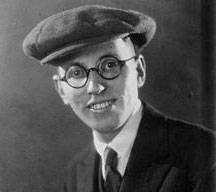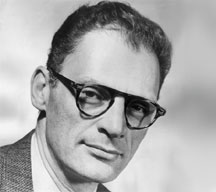Preamble
Expressionism was an avant-garde literary and artistic movement developed in Germany at the beginning of the 20th century. The term was first employed by the French painter, Julien-Auguste Hervé in 1901 and was subsequently applied to literature by Hermann Bahr in 1914. It came out as a revolt against Naturalism, which always searched for a precisely detailed realism. The expressionists, on the other hand, wanted to produce and make vivid their very own reality or their inner idea or vision of what they saw. They were more imaginative in handling of their subject matter. To them it was totally meaningless to produce a sole imitation of the world, and it is the very attitude (i.e. turning away from the physical reality) for which Expressionism could be deemed as the revival and development of the Romantic tradition. Expressionist drama introduced to a new approach to staging, scene design, and directing. Apart from drama, Expressionism is exhibited in many literary forms, including novel, short story, poetry, etc. The movement declined in 1930 with the rise of Adolf Hitler. Though existed for a short period, the movement exerted an epoch-making influence on modern art and literature.Definition
Akin to romanticism, expressionism is not easy to define. In fact, there are no yardsticks to define it in a precise term. Generally speaking, in expressionistic literature the author seeks to depict a character’s or his own emotional experience by representing the world or nature as it appears to his state of mind rather than to present the world or nature in a realistic way. In other words, in Expressionism the author’s or the character’s subjective/private emotions and responses to a subject are emphasized rather than the objective surface reality of the subject. Lucidly speaking, the expressionists tend to transform nature rather than directly imitating it. For this reason, the depiction in Expressionistic works is a fantastic distortion or altered representation of reality as the author or the character reshapes the objective image into his mind's image (subjective image) to depict his own version of reality. Sometimes the author or his character suffers from a psychological conflict, such as depression or paranoia, which helps to alter his perception of reality.Characteristics
There is no specific model or theory to distinguish the mode and temperament of the expressionist school of literature since the works of this movement represent a wide range of subjects. However, the major tenets of Expressionism are roughly as follows:Subjectivity: Expressionistic play tends to display an artist's internal, subjective experience to the world which is dominated by his own interpretation.
Abstraction: It is the act of considering or evaluating something in terms of general characteristics or qualities apart from specific objects and concrete realities. Expressionistic play employs this device in its every aspect, such as plot, structure, setting, atmosphere, characters, etc. to provide a distorted view. Such a distortion helps to create a more personalized/imaginative reality from the visual world.
Setting and Atmosphere: The setting and atmosphere in such play is vividly dreamlike, non-realistic, grotesque and nightmarish, where the depiction of life and the world is not photographically accurate as it often reflects the character’s state of mind which is often emotional, troubled, or abnormal.
Plot and Structure: The plot and structure of the play tends to be disjointed and broken into episodes, incidents and tableaux, each making a point of its own. Instead of the dramatic conflict of the well made play, the emphasis was on a sequence of dramatic statements made by the dreamer, usually the author himself.
Dialogue: The dialogue is often spoken in a sort of telegraphic style usually formed of short phrases of one or two words or expletives. Sometimes it also takes the form of long lyrical/poetic monologues.
Unorthodox Characterization: the characters are developed as everyman since they are often represented as social groups/masses rather than particular person. Such characters were merely identified by nameless labels, such as The Man, The Father, The Son, The Billionaire, etc.
Psychoanalysis: Freud’s theory of psychoanalysis provided many incentives for the expressionists to explore the subconscious forces in man. This becomes obvious in those plays where the study of deep and dark areas of the human soul gets priority.
Pessimism: The expressionistic play depicts the hollowness, meaninglessness, loneliness and isolation of modern man’s life in mechanical, industrial, acquisitive society, which definitely points towards a pessimistic view of the human condition.
Human Concerns: The writers sought to encapsulate the basic problems and issues of modern society with a view to reform it. These include:
- Oppression, war, dehumanization, anarchy, political instability, sex pervasion.
- Man’s predicament, struggle, sorrow and suffering.
- Stress on mankind, on human values, and on the spiritual brotherhood of man.
Chief Representatives
It is a strange fact that although the Movement was developed in Germany, most of its precursors were not from German descendent. Moreover, several non-Expressionist writers also wrote literary works with Expressionistic note. Even after the decline of this movement, there were subsequent expressionist works from German and non-German writers.Early Influences
The development of Expressionism was engendered by the following contributors:August Strindberg (1849 – 1912)
Swedish dramatist and novelist, whose work is characterized by its dark pessimism and dominance of emotion, instinct, and passion. Strindberg experimented with expressionistic ideas much earlier than the constitution of the expressionistic school of thought. He is, in fact, the forefather of Expressionism. Major expressionist plays by this author include To Damascus (1898-1904), The Dance of Death (1901), and The Dream Play (1902).
Sigmund Freud (1856 – 1939)
Austrian physician, neurologist, and founder of psychoanalysis, a theory claiming that much of our thinking and acting is strongly influenced by unconscious processes, such as innate sexual and aggressive drives. Freud's psychoanalytical approach played an important role in the development of Expressionistic School of thought.
Carl Gustav Jung (1875 – 1961)
Swiss psychiatrist, who is credited to be the founder of the analytical school of psychology. Jung expanded Freud's psychoanalytical approach, interpreting mental and emotional disturbances as an attempt to find personal and spiritual wholeness. His researches also provided much stimulus for the growth of the Expressionistic School of thought.
German Expressionists
Historians identify two different phases of Expressionism having independent principles of their own:1. Mysticism/Pure Expressionism: The major themes of Mysticism was personal struggle, the everyman, and God. The Mystics prioritized the need for achieving personal emancipation rather than directing a social protest. The chief leaders of this phase include:
Reinhard Johannes Sorge (1892 – 1916)
German dramatist and poet, whose work is noted for its pessimism. He is best known for writing the Expressionist play The Beggar (Der Bettler), which won the Kleist Prize in 1912.
Fritz von Unruh 1885 – 1970
German dramatist, poet, and novelist. Amongst many of his plays Offiziere (Officers, 1911), Ein Geschlecht (A Family, 1916), and its sequel Platz (Place, 1920) are considered to be his best Expressionist works.
Ernst Toller (1893 – 1939)
German playwright, who wrote plays of social protest in the style of expressionism. Best of his Expressionist works include Masses and Man (1920; trans. 1923, Brokenbow (1924; trans. 1926), Hoppla! Such Is Life! (1927; trans. 1928), and Pastor Hall (1939).
Georg Kaiser (1878 – 1945)
German dramatist, whose work deals with the impact of the modern machine age. Major Expressionistic drama by this dramatist include Morn to Midnight (1916; trans. 1922) and Der Silbersee (The Silver Lake, 1933).
Non-German Expressionists
Austrian (Czech) Expressionists
Franz Viktor Werfel (1890 – 1945)
Franz Kafka (1883 – 1924)
Czech novelist and short-story writer, whose central theme is various psychological conflicts, such as loneliness, and frustration reflected either in his central characters or in the society. His best works include The Metamorphosis (1915; trans. 1937), In the Penal Colony (1919; trans. 1941), The Trial (1925; trans. 1937), The Castle (1926; trans. 1930), and Amerika (1927; trans. 1938).
American Expressionists
Eugene Gladstone O'Neill (1888-1953)
American playwright, whose The Emperor Jones (1920), The Hairy Ape (1922) and The Great God Brown (1926), were influenced by Expressionism.
T.S. Eliot (1888-1965)
Anglo-American poet and critic, whose work is mostly concerned with the spiritual bankruptcy of contemporary society. He is often labelled as an Expressionist for his long poem The Waste Land (1922).
Elmer Leopold Rice (1892-1967)
American dramatist, noted for his expressionist plays, including The Adding Machine (1923) and Street Scene (1929).
Tennessee Williams (1911-1983)
American playwright, novelist, essayist, short story writer, screenwriter, and poet who is renowned for his psychologically complex dramas that explore isolation and miscommunication within families and small groups of misfits and loners. Nowadays, his reputation rests on his three award-winning dramas—The Glass Menagerie (1944), A Streetcar Named Desire (1947), and Cat on a Hot Tin Roof (1955).
Arthur Miller (1915-2005)
American dramatist, much of whose play is conveyed expressionistically. Miller's major achievement in Expressionistic style was Death of a Salesman (1949) which won the 1949 Pulitzer Prize for drama and the 1949 New York Drama Critics' Circle Award for best play of the year.
Irish Expressionists
Seán O'Casey (1880-1964)
Irish dramatist, whose successful plays exhibit a mastery of language and an unsentimental sympathy for the poor. His later plays were more expressionistic, they include The Silver Tassie, Within the Gates (1934), Purple Dust (1940), Red Roses for Me (1942), and The Bishop's Bonfire (1955).
James Joyce (1882-1941)
Irish author, whose work is marked for its psychological insight and inventive language. Joyce is considered as an Expressionist for his best known epic novel Ulysses (1922), which uses stream of consciousness.
References
“An Introduction to Expressionism.” Academia.edu. 2012. Academia. 2 September 2011
< http://fh-wuerzburg.academia.edu/IngoPetzke/Papers/1520573/An_Introduction_to_Expressionism>
“Expressionism (Literature).” Talktalk. 2012. Tiscali. 20 September 2012
< http://www.talktalk.co.uk/reference/encyclopaedia/hutchinson
/m0097410.html>
“Expressionism.” Wikipedia. 2012. Wikimedia Foundation, Inc. 2 September 2012
< http://en.wikipedia.org/wiki/Expressionism>
“Expressionism.” Infopleae. 2012. Pearson Education. 20 September 2012
< http://www.infoplease.com/ce6/ent/A0858069.html>
“Expressionism.” Quizlet. 2011. Quizlet LLC. 20 September 2012
< http://quizlet.com/11710951/world-theatre-and-drama-iii-midterm-flash-cards>
“Expressionism.” Museum-Online. 2011. Museum-Online. 2 September 2012
< http://www.museum-online.ru/en/Epoch/Expressionism/>
“Franz Werfel.” Kirjasto. 2011. Petri Liukkonen & Ari Pesonen & Kuusankosken
kirjasto. 2 September 2008
< http://www.kirjasto.sci.fi/fwerfel.htm>
“Literary Terms.” Cummings Study Guide. 2012. Michael J. Cummings.
20 September 2012
< http://www.cummingsstudyguides.net/xLitTerms.html>
Syed, J. W..“Expressionism In The Twentieth Century Literature.” Iqbal. 2012.
Iqbal. 20 September 2011
< http://www.allamaiqbal.com/publications/journals/review/apr70/3.htm>
NB: This article was last modified on September 15, 2019






















The last one- James Joyce
ReplyDeleteLooks like Charley Chaplin. But his face is more comical than Charley!
By the way, trying to understand the topic for 10 minutes. But I got tired. :)